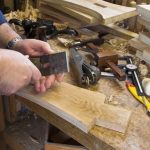Introduction
Woodworking encompasses a range of activities and depending on what type of woodworking you are doing, there are various saws and tools that can be used to complete the job. From rough cutting to fine finishing, a number of saws can come in handy. For example, for typical wood construction, a circular saw is used for rough cutting and can also be used for floors and large sheets of wood. A jigsaw or sabre saw is useful for curves or making cuts in tight spots. An electric handsaw is great for basic carpentry, such as cutting two-by-fours to length. If you’re looking to make dovetails or other intricate cuts, then specialized handsaws such as the coping saw, miter box saw, or tenon saw may be necessary. For more detailed projects requiring precise cuts an oscillating spindle sander might be necessary– it’s capable of sanding intricate shapes into wood pieces. Chisels and planes may also be required depending on the job at hand – these tools are used for shaving off small amounts of wood when creating jointsing or details that require precision cuts. With all this said, it’s important to know what type of woodworking project you need to complete prior to purchasing a correct tool set. Choosing the right combination of saws and blades will ensure that your project goes smoothly and turns out exactly as you had intended it!
Hand Saw
Hand saws are the traditional tool of choice for keen woodworkers. Each type of handsaw is designed to tackle a specific task, so it’s important to understand which saw type is best suited to suit your project.
• The rip saw has a sharply pointed tip and angled or straight teeth, making it ideal for cutting along the surface grain of the wood in a straight line – as when ripping boards along their length.
• The crosscut saw has broader, more strongly tapered teeth that may be V- or U-shaped and honed to an acute point at the top. This design means crosscut saws can make clean cuts across the grain with minimal effort and less than perfect technique.
• The keyhole saw has a rounded, three-sided blade and deep gullet for making holes for locks in doors and cutting circles in panels such as chair backs.
• The miter box allows you to make precise compound miters (joint between two pieces at an angle). It holds the work securely while you keep your eyes on the miter lines instead of watching your hands on the saw.
• Japanese pull-saw has blades that are adjustable for different depths, providing hobbyists with excellent control over both depth and width of cut in all types of woodworking projects. Its thin kerf leaves wood parts smooth with hardly any distortion during cutting or shaping.
Table Saw
Table saws are essential for woodworking. When it comes to setting up and using a table saw, the size and angle of the blade is of utmost importance. The best blades for table saws are typically 10-inch blades with a 0 degree hook angle. This is because the hook angle determines how aggressively the blade will cut into the material, so aim for no more than a 1 degree hook angle as that is best for ripping cuts.
A proper setup for a table saw includes consulting the user manual and ensuring that all safety features are engaged prior to use. Additionally, one should double check that all bolts, levers, and knobs are tightened down properly before powering up the tool. Lastly, regarding setting the blade, begin by raising it while turning off the machine and lining the teeth up with your markings on the intended cut line and lower slowly. Check to make sure everything is straight and lined up correctly before turning on; this ensures accuracy in your work piece!
Circular Saw
The circular saw is an essential tool for accurate and efficient woodworking. When selecting a circular saw, it’s important to consider the power level and RPM ratings that are available on the particular saw you’re considering. Knowing how powerful you need your saw to be will determine what type is suitable for your projects. Additionally, higher RPMs increase the speed of cutting; this is helpful when doing precision cuts or making intricate shapes or curves. Special features such as laser guide systems can allow for greater accuracy and ease of use, while variable-speed trigger support enables adjustable cutting speeds for varying materials. Furthermore, some circular saws come with dust blowers which can help keep line-of-cut visibility clear during lengthy projects or jobs with multiple cuts. With such features in mind and depending on the required application, you should be able to determine which circular saw is best suited for your woodworking needs.
Jig Saw
A good jigsaw for woodworking projects should have a blade that is designed specifically for cutting wood. blades made with high carbon steel are very durable and help to achieve smoother cuts, while blades made of bimetal are better for tackling tougher jobs. The saw should also be able to adjust the speed, as you’ll want to use a lower speed when cutting harder woods and a higher speed when working on softer woods. When it comes to power, opt for a saw that is powerful enough to cut through tough wood easily but gentle enough so you don’t accidentally overcut.
Band Saw
A standard band saw is typically a lower-powered motorized saw with a metal cutting blade, which is typically used for cutting through metal and hard materials such as steel or aluminum. A woodworking band saw has a higher power motor and a specialized blade designed for cutting, shaping and resawing wood.
Setting up the saw correctly will ensure the best performance and long-term serviceability of the machine. Proper tracking of the blades is paramount, as an appropriately-adjusted blade will result in improved efficiency with regard to power consumption and belt wear. Blade tension should also be taken into carefully consideration when setting up a band saw; too much tension can cause fatigue or memory deformation in the blade over time, while too little tension can lead to wobbling and inaccurate cuts. Additionally, when adjusting the tracking on your particular saw, it’s important to check that you don’t have anything obstructing the sides of the table, as this can cause undue resistance that increases wear on both the belt and the teeth of the blade itself. All of these factors contribute to maximizing safety during use.
Miter Saw
A miter saw is a tool typically used by woodworkers to make cuts in wood and materials such as steel or aluminum. The saw is capable of making a range of different cuts, including basic straight cuts (both crosscuts and rip cuts) as well as miter cuts and beveled cuts—that’s why it’s called a ‘miter’ saw! For example, when framing the inside of a door frame or window frame, one will use a miter saw to accurately cut the angle on each corner.
To use a miter saw correctly, ensure that it is bolted securely to the work surface or bench. Using clamps can also help keep the material steady while being cut. Additionally, always check for any obstructions before starting the saw; this includes hands, tools, clothing loose items near the blade that may be swept up. It’s important to use both hands when running the saw to ensure accuracy and reduce vibration from the machine. Finally allow it plenty of time to come up to speed before beginning your cut – for many models this will be done automatically but for larger units you may need to manually start the movement of the blades so they reach their full spinning speed before cutting into your material.
Conclusion
It is essential to have the right saw when working with wood. Different saws help create different cuts and finishes, making it important to use the right type of saw for the job. Popular types of saws used in woodworking include jigsaws, circular saws, table saws, band saws, reciprocating saws, and more. Each type of saw offers specific advantages when cutting wood and can vary based on uses such as construction, repair work, furniture making, small projects and trimming. Especially when starting out in woodworking, practice is important to get a feel for how each tool works best. With the right tools and some practice you will be able to create beautiful woodworking projects throughout your lifetime!

Hi everyone! I’m a woodworker and blogger, and this is my woodworking blog. In my blog, I share tips and tricks for woodworkers of all skill levels, as well as project ideas that you can try yourself.





